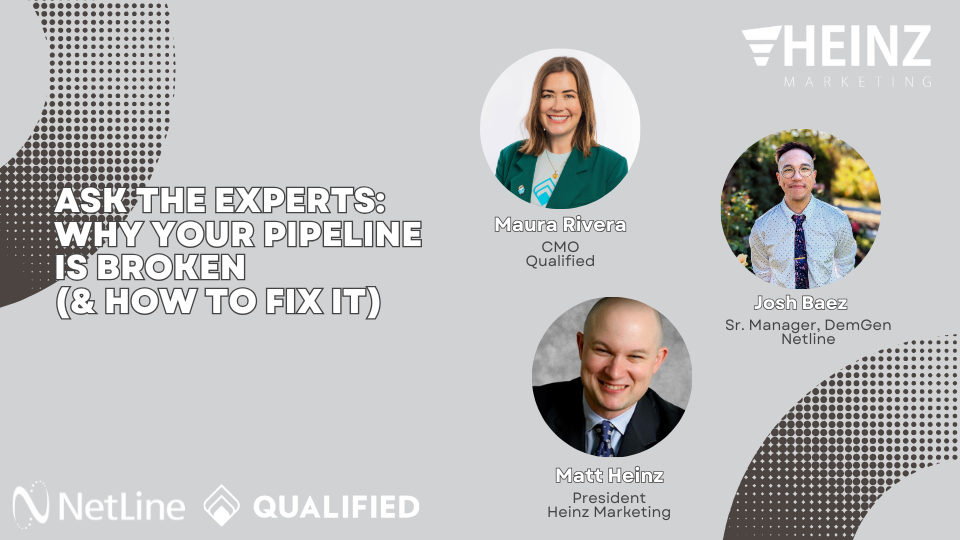Webinar Recap: Why Your Pipeline is Broken (and How to Fix It)

Summary
A predictable pipeline requires more than speed—it demands smart engagement, alignment, actionable data, and scalable processes. Speed to lead is crucial, but context and multithreading drive real conversions. Alignment across sales and marketing ensures shared goals, while intent-driven engagement turns data into meaningful action. Scaling requires AI and orchestration to maintain efficiency. Ultimately, success comes from simplifying processes, focusing on the right data, and enabling buyers on their terms. A strong RevOps foundation and clear GTM strategy are the keys to long-term pipeline predictability.
By Lisa Heay, Vice President of Business Operations at Heinz Marketing
Your pipeline shouldn’t feel like a rollercoaster—thrilling one month, terrifying the next. But if your sales and marketing teams are playing tug-of-war, if your data is more of a dumpster fire than a goldmine, or if your tech stack feels like a bad game of Jenga… read on and watch the on-demand recording below.
Josh Baez (Sr. Manager of Demand Gen, NetLine) put Matt Heinz (President, Heinz Marketing) and Maura Rivera (CMO, Qualified) in the hot seat recently to spill their best-kept secrets for turning pipeline chaos into predictable, scalable revenue in an Ask Me Anything style webinar titled Why Your Pipeline is Broken (and How to Fix It).
Key Takeaways
Josh asked Matt and Maura several questions throughout the webinar. Here are the highlights!
Speed to Lead
When the panel was asked what are the biggest pipeline killers in their minds, Maura explained that 78% of buyers go with the vendor that responds to them first. If you’re slow to engage, you’re already losing the deal.
Matt went on to explain that speed is table stakes, but follow-up is just as important. You need to be multithreading—engaging multiple stakeholders in the buying group. Who else has a stake in this decision? Winning the deal requires commitment from the group, not just an individual.
Ensuring Speed and Relevance
Speed to lead matters, but so does context. It’s not just about being first—it’s about being relevant. What’s important to the prospect? Engage with follow-ups tailored to their needs.
Nowadays, personalization should go beyond using someone’s name in an email. Intent-driven engagement is key. Leverage all your intent signals to craft meaningful outreach.
In addition, personalization at scale is the key to sustainable growth. AI agents can help ensure every lead gets the right engagement at the right time, without overloading your team.
Creating Alignment Across Teams
One of the biggest takeaways from this event is to ensure sales and marketing departments are on the same team. But how do organizations accomplish this?
Maura’s response was to start with the basics. Define what “pipeline” means and document your pipeline stages. Everyone in your go-to-market (GTM) organization should understand and align with these definitions. Shared pipeline metrics are critical—this isn’t about assigning credit but ensuring the company hits its goals. A weekly pipeline council where sales and marketing review successes and identify gaps keeps teams aligned.
Matt went on to say that if your team is focused on assigning credit, you’re having the wrong conversation. Pipeline success isn’t about isolated tactics—it’s about a repeatable process that drives results. You win and lose as a team.
With that, internal execution needs to be orchestrated properly. Collaboration drag can kill pipeline efficiency. Make sure your teams are working in sync to maintain momentum.
Finally, Josh wrapped up the discussion by reminding us that service-level agreements (SLAs) help clarify who you’re targeting, the types of engagement that matter, and which topics are resonating.
Data: The Difference Between Actionable Insights and Noise
The next discussion was around data. Maura explained that the problem isn’t around accessing data anymore—it’s making that data actionable. Intent data is a powerful tool, but you have to separate real buying signals from distractions. Frequency and urgency matter. A single website visit isn’t enough; layering first- and third-party intent data helps you identify true intent for a comprehensive understanding of prospects.
Matt added that marketers need to be the guide in translating signals into action. Pipeline oversight is critical—what happens after the handoff? Again, sales momentum depends on multi-threading and anchoring conversations on real business needs.
Hot Takes and Future Forecasts
Finally, Josh wanted to know our experts’ hot takes for the future of B2B Marketing.
For Maura, it’s to hire a great RevOps leader and simplify your playbook. Too much tech and too many process steps slow you down. More data isn’t always better data—focus on the right data.
For Matt, he brought it back to B2B marketing foundations that matter. Who are the companies and people within those companies you should be talking to? What do you need to say to capture their attention and drive action? Where and how do you share this information? A clearly documented and widely followed GTM strategy is the foundation of a predictable pipeline.
The Bottom Line
A predictable pipeline isn’t just about speed—it’s about smart engagement, alignment across teams, actionable data, and scalable processes. Deliver value consistently over time and enable buyers to engage on their own terms. The future of pipeline success is buyer enablement—are you ready for it?
This Ask the Experts webinar was a goldmine of information for anyone looking to enhance their marketing efforts. We’ll be doing these events quarterly throughout 2025, so make sure to bookmark your questions related to GTM Orchestration, Customer-led Growth, and 2026 planning, and keep a look out for those invites coming to your inbox in the coming months.
Watch now!
Want to chat? Email us for a free brainstorm session!







